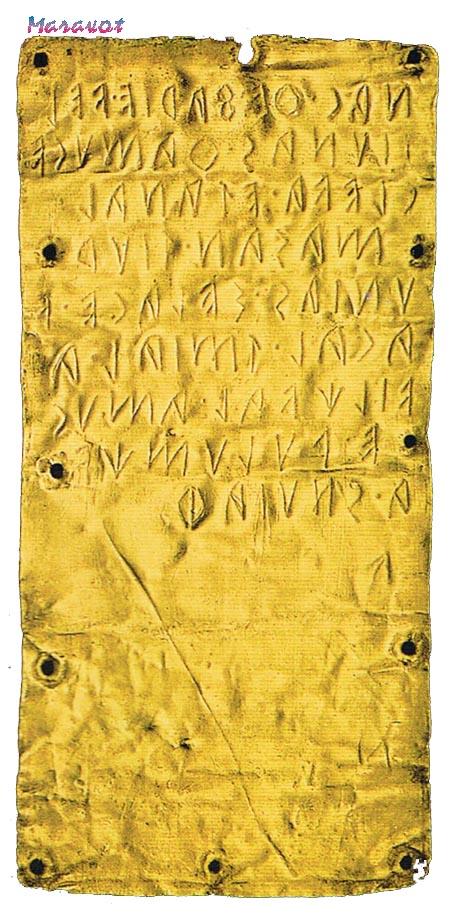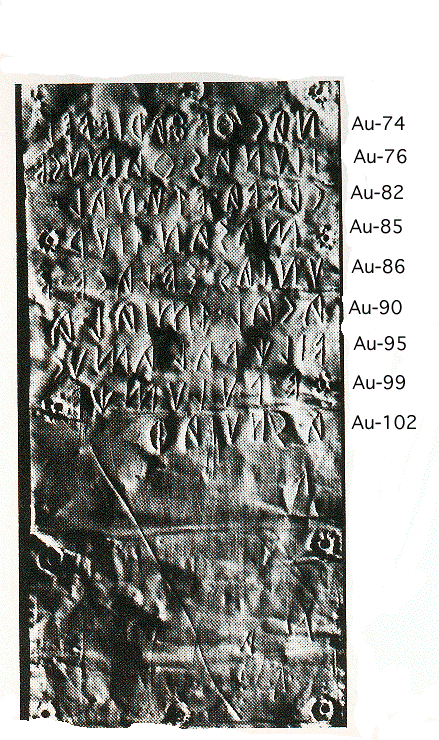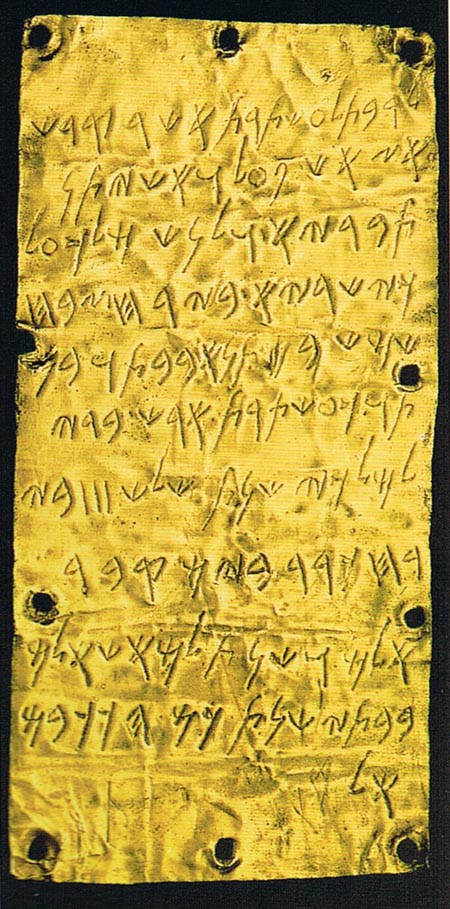Copyright © 1981-2006 Mel Copeland. All rights reserved.

Etruscan_Phrases
Translation of the
Pyrgi Gold Tablet # 2
| Θ |
|
|
|
|
|
|
|
|
|
|
|
|
| th | K | u ,o | G, i | L
rare |
G, I, F,V, O | G, I
V ,O |
M |
rare |
S | S,Z | S | S |
| |
|
|
|
O |
|
also interchanged with the V in the Zagreb Script |
8
(rare) |
L | B | b |
|

(the loop is rare; see script PS) |
| S,Z
S,Z |
AE? | B | P | R | R | V,F,u, o | V,F,u | L | B | G |
|
|
About the translation:
This is the concluding argument of the two gold tablets. A third is written in Punic. A translation with details below follows:

Au74 born she dreams/ponders of these matters
Au76 bitter of Junas, the goddess Juno; Greek Hera, Etruscan Uni, or alternatively, the Ionians I return to us
Au80 the staff, cudgel it thunders
Au83 they amass/crowd to you, yours I speak
Au86 of one the seat to us from, out of
Au90 he, she makes there; to you, your Maia, mother of Mercury, month of May there on/from, to, at
Au96 the fruitful/succesfulI deceive / lead astray / dissapoint / I am misled I love, wish; you prophesy
Au99 out of the controversy
Au-102 by, because of you sang of, celebrated [the goddess] Aph.
(end of text)

Au-74 NAC RE8A RIE
FEL [Translation: born (L. nascor-i, to born) she dreams/ponders (Fr. rever) of these matters (L. res, rei) (the "I" to FELI is on the next line)]
Au-76 (FEL)I IVNASRAMV CE [Translation: bitter (L. fel, fellis, the gall bladder, gall, bile, poison, venom, bitterness) of Junas (L. Iuno-onis, f. the goddess Juno; Greek Hera, Etruscan Uni), or alternatively, the Ionians (L. Iones-um) I return (L. remeo-are) to us (It. ce)]
Au-80 CLEFAETVNA Le [Translation: the staff, cudgel (L. clava-ae f.) it thunders (L. attono-tonare - tonui - tonitum, to strike with thunder, stun, inspire) there]
Au-83 MASANTI VR [Translation: they amass/crowd (Fr. masser); to you, yours (L. tibi; It. ti) I speak (L. oro-are)]
Au-86 VNIAS SELA CE
E
F (F goes to Au90) [Translation: of one (L. unus-a-um, gen. unius, dat. uni) the seat (L. sellae-e, f.) to us (It. ce) from, out of (L. e, ex)]
Au-90 (F)ACA LeTe MIA Le
A
[Translation: he, she makes (L. facio-facere; the "F" in FACA is on the preceding line) there; to you, your (L. te) Maia, mother of Mercury, month of May (L. Maia-ae) there (le); on/from, to, at (L. a)]
Au-96 FILiK FAL AM
VCE
(E from Au99); Translation: the fruitful/succesful (L. felix-icis) I deceive / lead astray / dissapoint / I am misled (L. fallo, fallere, fefelli, falsum) I love, wish (L. amo-are) you prophesy L. auguror-ari; Welsh, argoel-ion, omen; Persian, ukhra; Alb. ogur)]
Au-99 (E) PVLVMeKU (PVLVMeKF) [Translation: out of (L. e, ex) the controversy (Fr. polémique; It. polemica)]
Au100 A SvNVI Aø (APH); [Translation: by, because of (L. a) you sang of, celebrated (L. sono, sonare, sonui, sonitum) [the goddess] Aph.
Note: Aph is a frequently appearing name of a goddess in the scripts. But this is whom I think APH is: She may be an old Cretan mother goddess with attributes similar to Ishtar, Demeter, Hera and Juno. These texts identify Aph with the cow, and the ceremony recorded in them is on the feast day of Hera. Thus, these texts may be remembering an earlier version of the following: According to Edward Tripp (The Meridian Handbook of Classical Mythology, 1970, New American Library, Times Mirror) there was an old Cretan goddess known as Aphaea, who was worshipped by the Greeks under the name, Britomartis. She was the daughter of Zeus and Carme, daughter of Eubulus. She loved the hunt and was a favorite of Artemis. Minos, king of Crete, pursued the young woman amorously until, in depseration, she leaped into the sea. She fell into the nets of some fisherman and, according to some versions of her story, was thus saved. In the more usual and possibly the original version she became immortal at the moment of her supposed death. Her title as a goddess was Dictynna, translated as "Lady of the Nets." Late classical writers gave the same title to Artemis whose cult seems to have absorbed the features of the Cretan goddess cult. Under the name of Aphaea she was worshipped on the island of Aegina and also at Sparta.
Ishtar is mentioned in the Punic version of the text. To the Phoenicians she was known as Astarte, who was the goddess of fertility, sexual love and of war. Crops, newborn animals and firstborn children were sacrificed to her to assure fertility. The gazelle, dove and myrtle were sacred to her, and she was symbolized by a cow's horns, representing fertility. In Egypt the mother goddess is called Isis, also represented by a cow's horns. Ishtar was the mother goddess of the Babylonians and Assyrians.
The following is a translation of the Punic text:
Transcription of the Phoenician text according to Sabitino Moscati:
Lrbt l'shtr ?sr qdsh
'z 'sh p?l w'sh ytn
tbry' wlnsh mlk 'l
kyshry' byrh zbh
shmsh bntn' bbt wbn
tw k?shtrt 'rsh bdy
lmlky shnt shlsh III by
rh krr bym qbr
'lm wshnt lmpsh 'lm
bbty shnt km hkkbm
Translation of the Phoenician text according to Sabatino Moscati:
To [our] Lady Ishtar. This is the holy place // which was made and donated // by TBRY WLNSH [= The faries
Velianas] who reigns on // Caere [or: on the Caerites], during the month of the sacrifice // to the Sun, as a gift
in the temple. He b//uilt an aedicula [?] because Ishtar gave in his hand [or: raised him with her hand] // to
reign for three years in the m//onth of KRR [=Kerer], in the day of the burying // of the divinity. And the years
of the statue of the divinity // in his temple [might be ? are ?] as many years as these stars.Another translation provided by Professor Charles Krahmalkov, University of Michigan:
"My own translation of the text is: 'For the Lady, for Astarte, is this sacred '-sh-r (?place, shrine) that Thefarie Velianas, King of Cisre (=Caere), made and presented as a gift in (=?to, for) the temple; and he built its/her/the cella (=adyton), because She requested <it> of him, in the month of Kirur, on Burial of the God day, in year three of his reign. The sh-n-t (??years) of the statue of the goddess in her temple <??are> sh-n-t (??years) like these stars.'
"It's a difficult text to translate, because – in my opinion – it was written by someone whose first language was Etruscan and whose Punic (=Phoenician) was not too good, that is, he was translating literally from the Etruscan.
"The gold lamina is called in Punic (=Western Phoenician) a delt (comes into Greek as deltos) 'tablet'; these plaques, also made of wood or copper/bronze, were nailed to the wall of the sanctuary. In one Phoenician inscription from Cyprus the writer of a plaque wrote in the plaque-inscription: 'I wrote this bronze plaque, in which are the details of my benefaction, and nailed it to the wall <of the temple>,'
Hope this helps you. Let me know how it goes."
Charles Krahmalkov
September 7, 2006
This text parallels the Etruscan text. Ishtar was the mother goddess of the Phoenicians. She compares to Isis, the mother goddess of the Egyptians, and she is involved with the story of Osiris, the Egyptian god of Judgment and the dead. It is probable that the Etruscan Aph is Cybele ( who was also known for prophesy), and in the Aph.html one can see that the damage to the statue was to the genitals which probably had both male and female organs.
Attis plays a major role in the Tavola Eugubine.
In the Divine_Mirror.html we can now see the Spartan connection, since the entire story of Helen of Troy is shown on the mirror, and Helen was the Queen of Sparta who was first abducted by Theseus and restored to her throne and then ran off with Paris, the son of Priam, king of Troy. And that started the Trojan war. In the Divine_Mirror.html we see a goddess presenting Paris with a laurel crown. Next to the goddess is a deer, which is the symbol of the goddess of the hunt, either Aphaea or Artemis. The name above the goddess is MIAN. Next to Paris are the words: EL KIN TRE. Since Agamemnon (AKMEMNV), Meneleus (MENLE) and Helen's (ELINAI) names are fairly recognizable on the mirror, it would follow that Paris--also called Alexander--would also have a fairly recognizable name. Elkintre might be Alexander. MIAN might be another name for Pha/Artemis, since L. Maenas-adis, means f. a baccante, a prophetess. The connection Artemis has to the story of Troy is that she sent unfavorable winds to keep the entire invasion fleet of Agamemnon at Aulis. Then she demanded, according to the priest Calchas, the sacrifice of Agamemnon's fairest daughter. Her enmity towards Agamemnon stems from two accounts. The first is that Agamemnon boasted that he could hunt as well as Artemis. The other account places the blame on Agamemnon's father, Atreus. Atreus had promised the best lamb of his flock would be sacrificed to the goddess, but when it turned out to be the lamb born with golden fleece, he hid it from her. In this sense then we can see how the goddess would be crowning Paris to get back at Agamemnon, as well as having something to do with the prophesy that Paris would be the cause of the fall of Troy. The first of several prophesies dealing with the subject involved Aesacus, the prophetic son of Priam by Arisbe, who interpreted Priam's nightmare, that the firebrand who would set fire to Troy would be Paris. He argued that Paris should be killed. Priam gave the child to a shepherd, Agelaüs, who would expose it on Mt. Ida. The shepherd returned after five days and found that a she-bear had suckled the child. He could not bear to kill the child and reared it on his own. When he became an adult, he was readmitted back into the family of Priam, to serve as a prince. AECAI on the mirror may be Aesacus.
![]() Open Pyrgi_1Translation.html
Open Pyrgi_1Translation.html
![]() Etruscan Glossary
Etruscan Glossary
![]() Etruscan Grammar
Etruscan Grammar
![]() Return me to
Return me to ![]() Home
Home
![]() Etruscan Vocabulary2.html (Obsolete directory, words L >; replaced by Indo-European Table 1)
Etruscan Vocabulary2.html (Obsolete directory, words L >; replaced by Indo-European Table 1)
![]() Open the Divine_Mirror.html
Open the Divine_Mirror.html
![]() Open the Aph_Translation. This is the lower torso of what appears to be a female which has been purposely ruined in the area of the crotch, and the inscription has to do with the goddess Aph – further evidence on the controversy on Aph mentioned in the Pyrgi texts. The Capua Tile also shows deliberate destruction, and if I had a fair copy of it I have no doubts that it would contain another dedication to Aph. The Capua Tile is in a museum in Germany. I am not having success contacting anyone in the museum who can supply me with a better photo of the tile. If anyone out there can get them to email me I would greatly appreciate it. And perhaps history will appreciate it as well.
Open the Aph_Translation. This is the lower torso of what appears to be a female which has been purposely ruined in the area of the crotch, and the inscription has to do with the goddess Aph – further evidence on the controversy on Aph mentioned in the Pyrgi texts. The Capua Tile also shows deliberate destruction, and if I had a fair copy of it I have no doubts that it would contain another dedication to Aph. The Capua Tile is in a museum in Germany. I am not having success contacting anyone in the museum who can supply me with a better photo of the tile. If anyone out there can get them to email me I would greatly appreciate it. And perhaps history will appreciate it as well.
Launched 10.03.01
Updated: 10.20.02; 6.22.03; 10.12.03; 5.29.05; 11.17.05; 2.12.06; 9.04.06; 9.14.06
Visitors since 2.05.06
Copyright © 1981-2006 Maravot. All rights reserved.
Copyright © 1981-2006 Mel Copeland. All rights reserved.
Use of the information on this page for publication in any media is expressly forbidden without the prior written consent of the author.
